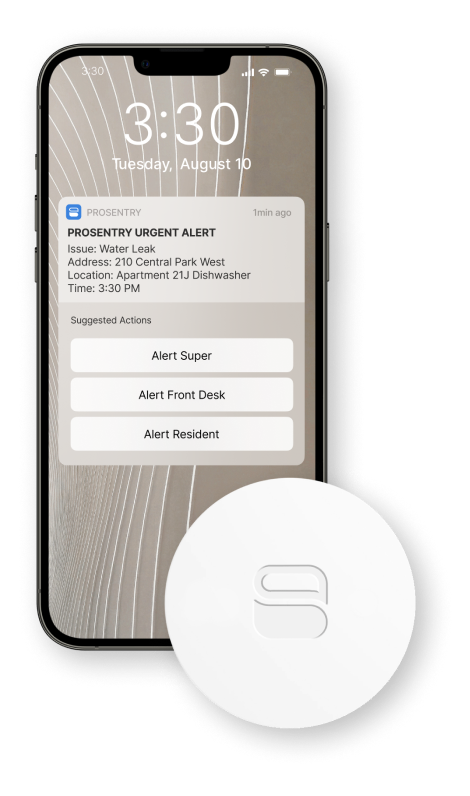“It’s actually the golden age of EV charging amenities, especially in multi-family,” says Chris Kluesener, Co-founder and CEO of Matcha Electric. While headlines about elec...
ProSentry Advances Leak Detection in Multi-Family Buildings




“Last year we caught 3,610 leaks. We reported them so quickly to the buildings that not one of those turned into an insurance claim,” says John Rusk, co-founder of ProSentry, a risk mitigation service that significantly improves how multi-family buildings detect and respond to water and gas leaks.
That’s a remarkable statistic: 3,610 potential disasters averted with zero false positives. For property managers and building owners, these numbers represent millions in saved repair costs, prevented displacement of residents, and substantial insurance premium reductions.
A Personal Disaster Sparks Innovation
Rusk’s journey to founding ProSentry began with his own property disaster. After 39 years running Rusk Renovations, a high-end residential construction company in New York City, Rusk experienced firsthand the devastation water damage can cause.
“About five years ago, in our house in upstate New York, I got a call from one of my neighbors because I had asked him to check on my house. I had received a report [on a smart home device] that I had a low temperature, which I didn’t really believe because my Nest thermostat was showing 50 degrees,” Rusk recalls.
The reality was far worse than a faulty thermostat reading. “He called me back and said, ‘Yeah, it looks like water’s been running through the ceiling for probably the last five days. There’s so much water that there’s icicles formed outside of your kitchen window. And the ceiling’s fallen. It’s kind of a mess here.'”
This personal disaster led to an epiphany. After his insurance company offered him a $5,000 credit toward an AI-controlled valve, Rusk began researching water leak detection systems. He quickly realized that while solutions existed for single-family homes, there was a significant gap in the multi-family building market—a space he knew intimately from his decades in construction.
“For 39 years, my clients, where we’ve built their apartments, have occasionally experienced leaks from above. That’s very common in New York City buildings—the water comes from above, through your ceiling, and then leaks through your floor into the next apartment,” Rusk explains. Clearly a report from the neighbor below wasn’t an ideal ‘leak detection method,’ and Rusk got to work exploring better options for the multi-family space.
Building a Better Solution for Multi-Family Buildings


The challenge was creating a system that would work effectively in large residential buildings with their unique constraints. Traditional building management systems (BMS) weren’t designed for comprehensive leak detection.
“While BMS systems do have the ability to have water leak detectors, it’s not really cost-effective to hardwire all of the required devices for detection,” Rusk notes. “The other issue with BMS systems is that they’re overly sophisticated — oftentimes there’s a server in the basement, and you need to train somebody to run it.”
This training issue creates a vulnerability: “You train them how to run this machine, and then that person says, ‘That’s fantastic. I’m now going to apply for other jobs for buildings that have BMS systems.’ And then the employee leaves for a higher paying job, and all of a sudden there’s nobody who’s trained to run the system.”
The technological breakthrough came when Rusk began exploring a new wireless protocol that made ProSentry possible. He came across LoRaWAN (Long Range Wide Area Network) technology, created by “a couple of French friends” who were fascinated by how whales could communicate over vast distances underwater, and the technology allows devices to send small packets of data over long distances while using minimal energy.
This energy efficiency, combined with the ability to communicate through steel and concrete, makes LoRaWAN ideal for multi-family buildings.
“All of our devices have a 10-year battery,” Rusk explains, holding up a small sensor. “This device has a 10-year battery, which is amazing, and it communicates water leaks and also low temperatures and high temperatures.”
A single gateway can cover multiple floors, dramatically reducing installation costs compared to Wi-Fi-based systems that would require a router in every apartment.
The Staggering Costs of Undetected Leaks
The financial impact of water and gas leaks in multi-family buildings is enormous. While the average water leak nationwide costs around $15,000 in single-family homes, that figure skyrockets in apartment buildings.
“In New York City, I’ve seen Chubb Insurance data vary between $65,000-$95,000 as their average water leak cost,” Rusk says. “And they generally report people being out of their homes for an average of 3 months to address the leak damage.”
Gas leaks present an even more frightening scenario. Beyond the catastrophic risk of explosions, there’s a significant operational risk when gas service is shut off due to a suspected leak.
“For gas leaks that are reported to the fire department, and then the fire department comes to the building and can’t find the gas leak and has to shut down the gas service—that is the thing that most buildings fear,” Rusk explains.
Once gas service is shut off, restoring it becomes a nightmare scenario. “To get the gas turned back on after it’s been turned off at the curb, you have to pressure test the whole building. To do that, you have to disconnect every appliance from the wall, get a licensed plumber to pull a permit, disconnect all those stoves, cap them, and then pressurize this building that might be 100 years old with 600% of its normal operating pressure of gas.” Clearly this a nightmare scenario that’s all too real for building operators that have experienced it.
In fact, Rusk remarks that few older buildings can pass such a test without showing some leakage. “For most buildings, such a testing process means there’s potentially hundreds of leaks. So they’re just better off replacing all the piping in the building, which can cost hundreds of thousands, if not millions, of dollars.”
Rusk cites a current example: “Right now, there’s a housing complex in Yonkers that had this problem, couldn’t find the gas leak, and they’re spending over $15 million to replace and turn over to electric, because that’s cheaper than repiping it all in gas.”
The ROI of Prevention
Despite these potential costs, convincing property managers to invest in preventative technology can be challenging. Rusk breaks down the return on investment into three categories: decreased repair costs, insurance savings, and risk mitigation.
The repair cost ROI is complicated by how banks value properties. “When we’ve spoken to owner-operators, they say, ‘Yeah, decreasing my repair costs isn’t going to increase the value of my property, because the banks don’t take that into account,'” Rusk explains.
However, the insurance savings are more concrete. “The more solid ROI is on insurance,” Rusk says. “If I look at two buildings and you’re deciding the risk—because on commercial policies, they evaluate the risk and give a premium and a deductible according to that risk—if one has a water leak detector and temperature sensor at every single point of possible leak throughout the building, and the other one doesn’t have any of that protection, naturally, the one with water leak detectors and temperature detectors is lower risk.”
These risk reductions translate to real savings. “One company using our solution, his building saved $300,000 on their insurance renewal, in large part because of their ProSentry system. We have a white paper on our website about a casino in Atlantic City that saved about a million dollars a year by putting in ProSentry after they’d had a large water loss.”
Major insurers are taking notice. “Chubb Insurance, who we’re fully approved by or vetted by, they will give up to an 8% discount in New York State for their clients who live in a building with a full ProSentry system,” Rusk notes.
New York’s Local Law 157: A Game-Changer for Gas Detection


The conversation around leak detection in New York City has intensified due to Local Law 157, which requires natural gas detectors in virtually every dwelling with gas service by May 1, 2025.
This legislation was sparked by tragedy. “It all started in 2014 with a massive gas explosion in Harlem that leveled the building, killed eight, injured 20 or 70. The following year was the East Village gas explosion that killed two, injured 20,” Rusk recounts.
While there’s speculation about a possible extension due to device shortages across the industry, the law is already in effect. The only question is when enforcement will begin.
ProSentry’s monitored gas detectors offer a significant advantage over basic models. “Those smart devices, when they go off, we call the building within a minute of the gas leak starting, so that they can respond right away—go upstairs, turn off the gas, open the window, go back downstairs, meet the fire department so they don’t turn off the gas.”
Beyond Water and Gas: The Future of Risk Mitigation
ProSentry continues to expand its sensor offerings beyond water and gas detection. “I’m excited as we’re adding new detectors and sensors on our platform,” Rusk says. “We have water leak detectors, humidity detectors, which are great down in Florida when there’s high humidity from somebody leaving a door open and going away with their AC off.”
The company is also developing smoke and vape sensors “for places where there’s not supposed to be smoking or vaping,” as well as lithium battery detectors. Even mouse traps are part of their ecosystem: “Our mouse traps are working amazingly well,” Rusk notes.
As climate change concerns drive municipalities to reconsider their relationship with natural gas infrastructure, ProSentry’s technology offers a bridge solution. “As we change to non-fossil fuels, we still have a ton of infrastructure which is fed by gas, and gas is incredibly efficient for doing things like heating and cooking,” Rusk explains.
The challenge is that many apartments lack the electrical capacity to switch from gas to electric appliances. “Most apartments may only have 60 amps feeding the whole apartment for their air conditioning, lighting, and outlets, because the stove doesn’t take any energy. But a standard induction-type electric stove may take between 40 and 60 amps.”
By making existing gas infrastructure safer through advanced detection, ProSentry helps municipalities manage this transition period. “If we can cut down on the gas leaks, it also makes a greener future. And then, as we increase the grid’s strength, add on natural green weather sunlight sources, maybe we’re ready to turn over to renewable sources in 20 or 30 years. In this period, we’ve made it much safer to live with gas as infrastructure ages.”
With plans to expand beyond New York to Washington DC, Philadelphia, Florida, California, Boston, and Texas, ProSentry is positioned to improve how multi-family buildings approach risk mitigation nationwide.
“We are a risk mitigation as a service company,” Rusk summarizes. “We like to talk to a building, find out what their risks are, and then come up with solutions that can help mitigate that.”
Given their record of 3,610 leaks detected with zero false positives and zero insurance claims, it’s clear that ProSentry’s approach is effective—keeping residents safe, buildings dry, and property managers’ budgets intact.
Similar Articles
Explore similar articles from Our Team of Experts.


With most homebuyers starting their search online, visual presentation has never been more critical. Collov.ai is helping real estate professionals meet this demand with speed and precision....


Algoma, an AI development platform, is transforming how developers approach site feasibility. By automating pre-construction services through AI-powered technology, the company has reduced w...


“What if I could show you five or six actions that statistically reduce your likelihood of lease churn by 10 percentage points?” asks Ray Hespen, CEO and Co-Founder of Property M...


“For every 50 contractors that retire, only seven enter the workforce,” explains Shanna Greathouse, Founder and CEO of Pigybak, a startup at the intersection of social impact and...




